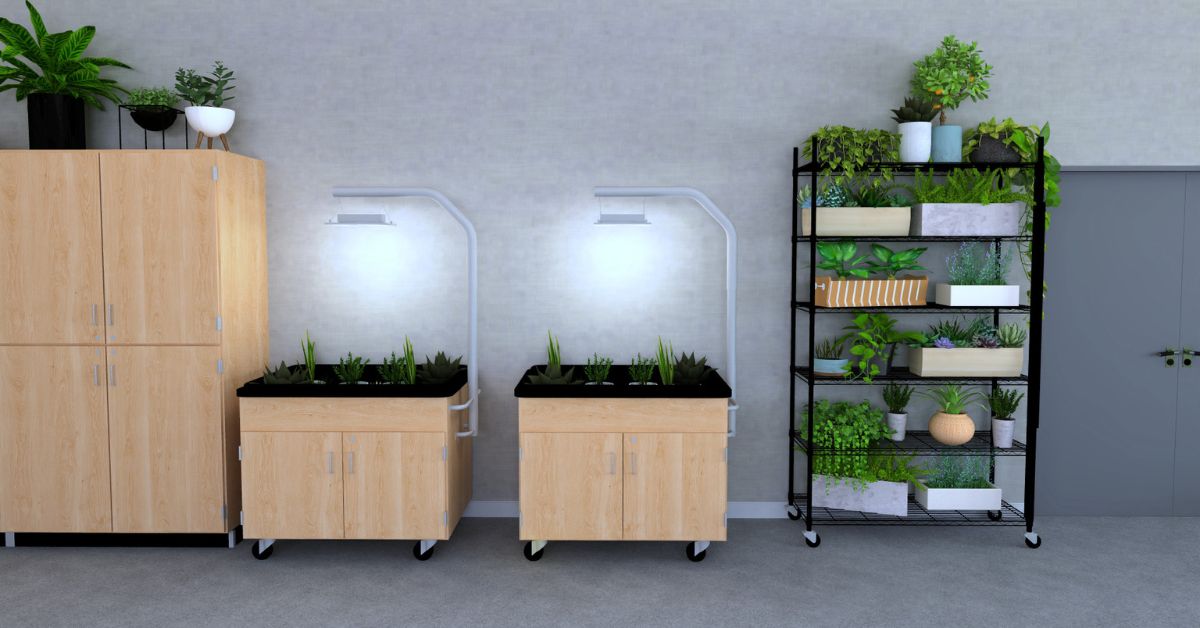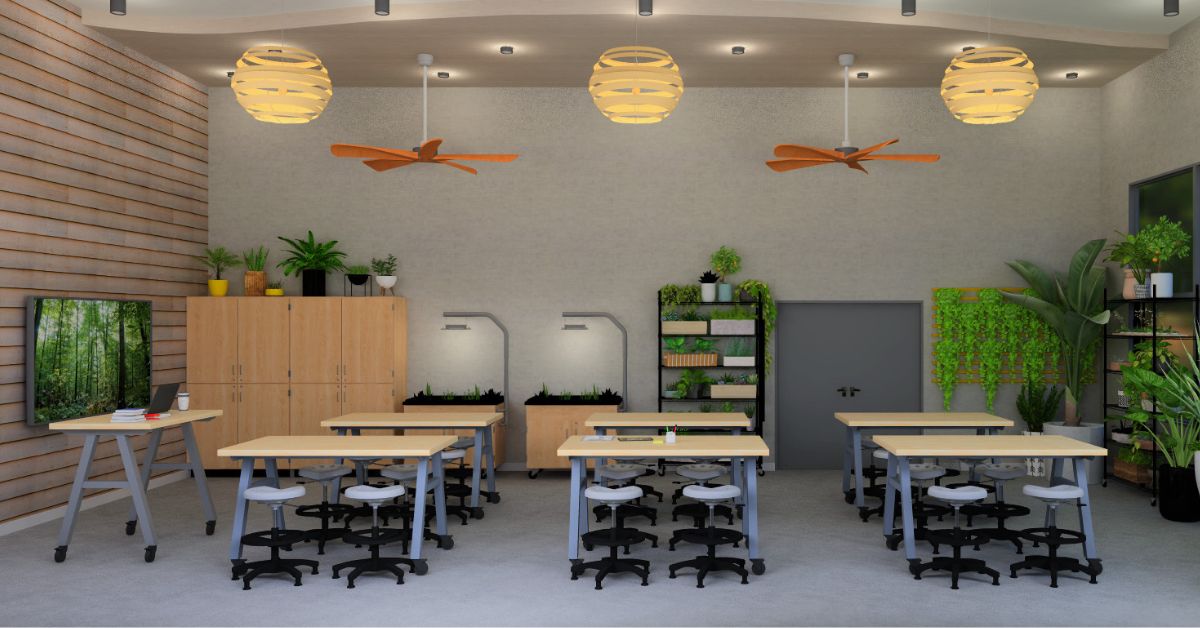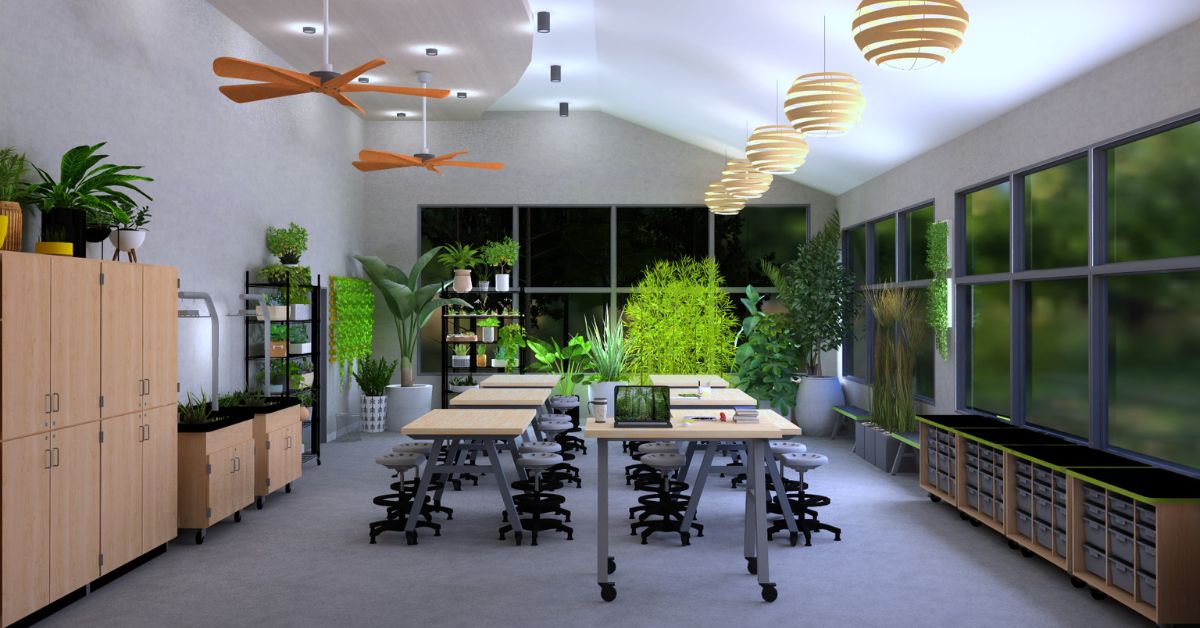Ever notice how it’s easier to focus in a room with natural sunlight flowing in? Or how relaxed you feel after stepping outside for some fresh air? There’s actually science behind that.
Now, imagine taking those natural elements – like natural light, greenery and other organic materials – and using them to design a STEAM (Science, Technology, Engineering, Art and Mathematics) classroom to improve student learning.
That’s the power of biophilic design.
What Is Biophilic Design?
Biophilic design is about bringing nature indoors to make spaces feel healthier and more inviting. It’s more than just sticking a few plants here and there. It’s about carefully choosing elements from nature to help students feel calm, energized and ready to learn.
In practice, this could mean:
- Filling rooms with natural sunlight to keep energy levels up (and prevent sleepy afternoons).
- Incorporating real materials like wood or stone that feel warm and inviting to the touch.
- Adding greenery like some potted plants on desks, a vertical garden wall or even small indoor gardens students can care for.
- Bringing in subtle water elements like tabletop fountains or aquariums for a soothing vibe.
- Choosing colors and patterns inspired by nature, like earthy tones or botanical prints, to make the classroom welcoming and comfortable.
Why Biophilic Design Works for STEAM Education
1. It Lowers Stress and Helps Students Feel Good
Step into a STEAM classroom and you’ll instantly sense the energy. Students are collaborating, experimenting and tackling hands-on challenges. With so much going on, providing a well-designed space where students can feel calm and relaxed without losing that creative spark is important. That’s where biophilic design comes into play.
In a study on biophilic classrooms, students in a nature-infused learning environment reported significantly lower stress levels. By the end of the semester, only 35% of students in the biophilic classroom reported high stress levels, compared to 67% in the traditional classroom. Additionally, these students showed greater reductions in heart rate variability, a key indicator of stress reduction. This significant reduction in stress levels is a testament to the positive impact of biophilic design on students’ well-being.
2. It Improves Focus and Cognitive Function
Whether students are coding a robot or creating art, STEAM activities often require intense concentration and clear thinking. Thankfully, biophilic design can help students stay mentally sharp.
Studies have found that natural light and outdoor views can increase test scores by 7–18%. Simply put, students can concentrate better and think more clearly in nature-inspired spaces.
3. It Sparks Creativity and Innovation
STEAM is all about thinking outside the box. And guess what? Biophilic design can help with that. In fact, research shows that spending time in nature can improve creative problem-solving skills by up to 50%.
That means students in a classroom filled with natural textures, greenery and sunlight are thinking bigger, making connections and coming up with ideas they might not have otherwise.
4. It Makes Hands-On Learning Even More Exciting
Hands-on experimentation is the most important aspect of STEAM learning. And when nature becomes part of the classroom, hands-on learning gets even better.
Students can grow their own gardens or hydroponic gardens instead of just reading about it using our Hydroponics Growing System or Sprout Plant Growing Stand. Instead of crunching numbers on renewable energy, they can test solar panels and wind turbines outside and see physics in action. Even something as simple as using natural material in makerspaces gives students a real-world connection to sustainable design.
Biophilic design turns classrooms into living labs where students don’t just learn science. They experience it firsthand.

Let’s Create an Engaging STEAM Environment
While there are many ways to design a STEAM environment, biophilic design is the secret ingredient to keeping students engaged, focused and feeling their best.
Ready to bring nature into the classroom? At Diversified Spaces, we can help. Reach out today and let’s discuss how we can create a STEAM space your students will love.


